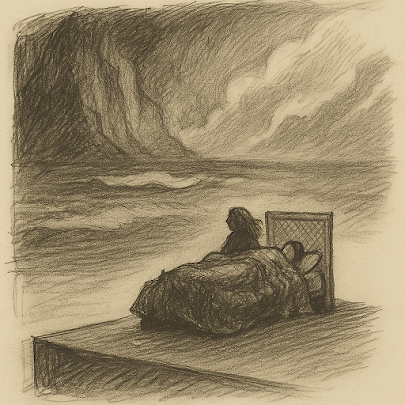"Space remembers what memory forgets."
Joel doesn’t want to remember Clementine.
That’s the premise. But the film doesn’t unfold like a typical breakup story.
Instead, “Eternal Sunshine” creates a theatrical memory map, where love isn’t told through plot but through spaces being dismantled.
It’s not about forgetting someone. It’s about watching your inner world collapse, wall by wall.
1. The Rooms We Used to Live In
Joel undergoes a memory-erasing procedure, but we’re not shown data or flashbacks. We’re shown rooms.
A beach in winter. A bookstore with shifting shelves. A sink where they brushed their teeth.
Each memory unfolds as a fully lived-in space—intimate, tactile, real.
And then, slowly, each begins to glitch, blur, or vanish.
This isn’t nostalgia.
This is architecture being disassembled by emotion.
2. Edits as Set Changes
The film’s editing feels like a scene change in theater.
One door opens onto a different memory. A hallway leads into a past conversation. A kitchen warps into childhood.
Time doesn’t pass. It rearranges.
This spatial storytelling mirrors how memory actually works—nonlinear, unstable, emotionally charged.
Gondry and Kaufman create a surreal stage where the collapse of love is shown through spatial breakdown.
3. The Home as a Feeling Machine
As Joel resists the procedure, he tries to hide Clementine in memories untouched by the erasure team.
He goes deep: under a kitchen table from childhood, into his mother’s arms, inside a blanket fort of memory.
It’s ironic—to save love, he retreats further into himself.
What he seeks isn’t just Clementine—it’s the spaces where he once felt safe.
This says something profound: we remember people by the places we shared with them.
In the end, grief isn’t about missing a person.
It’s about wanting to return to the room you were both in.
🎬 Spatial Overview
| Location | Mood | Emotional Function |
|---|---|---|
| The Beach | Empty, blue-gray, echoing | First connection / final goodbye |
| The Train | Neutral, in motion | Curiosity, newness |
| The Apartment | Dim, cluttered, fading | Domestic intimacy, loss |
| The Disintegrating Rooms | Warped, flickering | Collapse, resistance, survival |
Final Thoughts
“Eternal Sunshine” isn’t about memory loss. It’s about spatial grief.
It tells us that love isn’t stored in timelines, but in physical spaces that once held it.
Every room becomes a stage. Every object, a memory cue.
And when love dies, we don’t forget all at once—we wander through its ruins.







Post a Comment